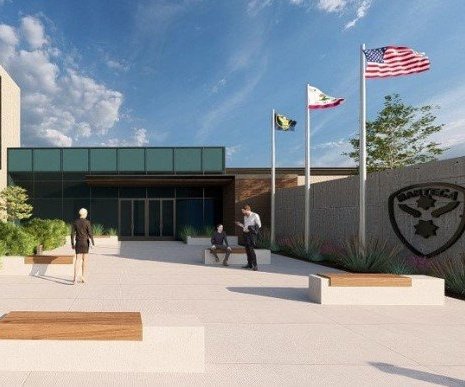Downtown Manteca generally has a surplus of parking spaces.
And because of that, the city may consider dropping parking requirements for infill commercial projects in the specifically defined downtown district.
Such a move could have a major impact on encouraging more private investment in Manteca’s core.
That’s because national cost averages that are usually lower than in California and compiled by private sector firms put the cost of constructing ground level parking at between $1,500 and $3,000 depending upon whether asphalt or concrete is used.
The estimate doesn’t include the cost of land.
In the downtown area it would mean projects would be too small to be economically feasible in most cases.
And in order to do a larger project, additional land would have to be secured which may not be available.
An underground parking structure carries a $27,000 to $35,000 space per stall based on national averages.
The parking survey by AECOM and recommendations are going before the Manteca Planning Commission when they meet Thursday. Aug. 15, at 6 p.m. to review proposed changes to the downtown zoning to conform with the updated general plan.
The survey was conducted in May and June on weekdays at noon and 1 p.m. as well as weekends at noon, 7 p.m., and 8 p.m.
The area surveyed reached northward to Alameda Street along Sycamore, Maple, Main, and Grant; as far as North Street between Grant and avenues, as far east a Sheridan Avenue between North and Yosemite plus as far east on Garfield between Yosemite and Moffat; south to Moffat between Main and Garfield, south to Wetmore Street angling up Stockton to Park, south to West Yosemite between Park and Veach, and west on Center to Walnut.
Vacant vs used spaces
& parking management
The survey provided exact counts of off-street and on-street spaces in terms of those that were vacant and occupied at specific times.
AECOM also recommended parking management options for specific “hot spots” where parking is at a premium.
In doing so, it noted under heavy use periods outside of major events such as street fairs and such, parking spaces were available within one to two blocks of hot destination.
Depending upon the downtown block, that’s roughly the distance walking from the farthest northeast corner of the Manteca Costco parking lot to the store’s entrance.
The downtown area includes 2,686 on -street spaces and 2,665 off-street spaces. The counts include regular and handicapped spaces.
*The average on-street parking space occupancy on a Thursday from 9 a.m. to 9 p.m. was 28 percent.
*The average off-street parking space occupancy on a Thursday from 9 a.m. to 9 p.m. was 20 percent.
*The average on-street parking space occupancy on a Thursday at noon was 33 percent.
*The average off-street parking space occupancy on a Thursday at 1 p.m. was 28 percent.
*The average on-street parking space occupancy on a Saturday from 9 a.m. to 9 p.m. was 24 percent.
*The average off-street parking space occupancy on a Saturday from 9 a.m. to 9 p.m. was 19 percent.
*The average on-street parking space occupancy on a Saturday at 7 p.m. was 27 percent.
*The average off-street parking space occupancy on a Saturday at noon was 19 percent.
In terms of parking hot spots:
*Weekday hot spots of high occupancy occurred adjacent to food establishments, retail, and other services near Center Street, North Maple Avenue, North Main Street, and West Yosemite Avenue, adjacent to residential uses near Fir Street, as well as adjacent to residential uses and the Manteca Unified health services near East North Street.
*Weekend hot spots of high occupancy occurred adjacent to retail and other services near North Maple Avenue, North Main Street, and Yosemite Avenue, and adjacent to residential uses near Stewart Street and Fir Street.
*Where hot spots of high occupancy occurred, additional parking spaces were available within 1-2 blocks.
AECOM noted the City may consider short-term and long-term parking management strategies to help address parking concerns and future parking needs.
Such strategies can increase parking space turnover in high occupancy areas, such as near retail and service uses on Maple Avenue and Main Street, prevent spillover into nearby residential areas, and accommodate future parking demand.
Strategies may include:
*establishing time limits for on-street parking
*installing parking meters in select locations to encourage more frequent turnover and increase revenue for local improvements
*implementing a residential parking permit program.
*Improving infrastructure for multimodal alternatives such as pedestrian, bicycle, and transit-related uses.
A downtown business group, such as the Downtown Manteca Community Benefit District being formed, could also collectively action to implement a shared parking program for existing businesses, or an informal agreement among businesses to direct employees away from high parking demand and limited space. That would help to increase the frequency of parking turnover near storefronts.
The City may also consider eliminating parking requirements for new developments in the downtown zoning district.
In existing developed areas, such as Downtown Manteca, requiring infill development to construct off-street parking can introduce project design and cost feasibility concerns.
The cost of constructing new surface or structured parking for new development can represent a constraint for infill development, whether it be market-rate housing, affordable housing, or non-residential development.
AECOM noted by removing any requirement for new off-street parking for infill development in the downtown general plan land use designation area, the City can help facilitate reinvestment, infill development, and housing in the downtown area.
The report submitted with the survey notes “given the overall surplus of existing parking in the area, and given the possibilities for managing the parking supply (through pricing, time limits, employee parking policies, etc.), the City could consider eliminating parking requirements for new development in this area.”
To contact Dennis Wyatt, email dwyatt@mantecabulletin.com






